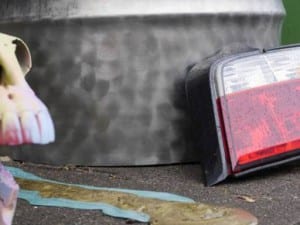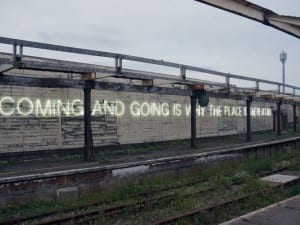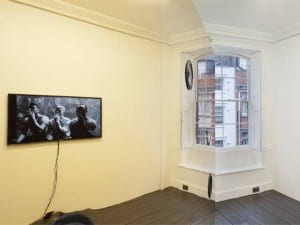One of Pakistan’s most exciting and engaging artists opened her new show, Karachi Series, at Green Cardamom.
Bani Abidi (b. 1971) is one of the leading figures from a generation of Pakistani artists, such as Shahzia Sikander, Asma Mundrawala and Ambreen Butt, who all trained during the 1990s and began exploring the paradoxes of social contradictions through their artistic practice. Abidi’s profound social observations have been informed through her experiences living in Pakistan, the United States and India. Although a much quieter artist commercially, Abidi’s precise and complex social commentary has seen her work gain significant critical acclaim over the past few years, with the curator of the Museum of Modern Art in New York even describing her work as “the best thing of 2008.” Her videos, photographic works and drawings use elements of performance and orchestration to explore the processes of political history as in The Ghost of Muhammad Bin Qasim (2006), popular imagination and identity formation. Abidi is most certainly an artist to keep an eye on, but not only that; her work tackles the most relevant themes of today.
Opening this February at Green Cardamom in London, Abidi will present two new works: Karachi Series 1 (2009), a photographic investigation into, and a lament for the loss of Pakistan’s diverse cultural character in the face of the Islamisation of the nation that began in the 1980s. This work was shown for the first time at the recent 10th Lyon Biennale curated by Hou Hanru. The second work, Intercommunication Devices (2009) is a set of digital drawings, where Abidi uses the idea of assembling a visual archive to explore prohibited spaces, or what Itty Abraham refers to as “Security aesthetics.” Intercommunication Devices investigates the meeting point where power and privilege meet the disempowered and excluded. This work follows closely on from her much acclaimed Security Barriers AL (2008), another example of the artist’s engagement with exclusionary architecture and spatial controls, also exhibited at the 10th Lyon Biennale.
Karachi Series 1 consists of a series of six photographs on light boxes, all featuring a central character involved in a seemingly mundane, domestic activity in the middle of a deserted street at sunset. The light, the postures of the figures and the ease of their activities create a gentle and shared melancholy in each scene. The images, and by extension the protagonists, are clearly part of a larger universal narrative. The accompanying titles list names, times and places that bring to the forefront the common circumstances of their creation. The photographs are all taken in Karachi in the last 10 days of August 2008; all at roughly 7:45pm; and the names of the individuals suggest that they are part of the non-Muslim minorities of Pakistan – Christian, Parsi and Hindu. Karachi Series 1 is an exploration of the place of religious minorities in a public environment not known for its acceptance of difference. During the month of Ramadan (in August at roughly 7:45pm) at sunset, the time when Muslims break their fast, the streets of Karachi are deserted. By venturing into the street and performing everyday tasks in public, Abidi’s non-Muslim subjects reclaim a time and a place where their status as equal citizens in metropolitan Karachi is not contested.
Intercommunication Devices records the range of intercoms found on the front gates on a street in the Defence Housing Authority, a perceptibly wealthy area in Karachi. They consider the notion of “intercommunication” between the private space of an “upper-class” household and the public space of the street. The clean, almost sales catalogue-like treatment of Abidi’s digital drawings, faithful in every detail to the objects they describe, without providing any visual information about the surroundings from which they are extracted, is both intriguing and disarming. Reduced to their pure form, in the style of a technical drawing, they are performative, inviting a closer scrutiny of their function as objects. Abidi raises a series of critically relevant questions: what do systems of control do? What social environment requires the systematic exclusion of violent threat? Are these divisions of class and power really so binary? Perhaps it is more interesting to read the spaces she creates as signifying multiple points at which the possibility of transgression exists, where barriers can be crossed and communication is made possible.
Bani Abidi in conversation with Francesco Cincotta:
Bani what were your early projects like, those you did when you were in school in Lahore or immediately afterwards, and how did they evolve?
I was studying painting and printmaking at the NCA (National College of Arts in Lahore) and it was a lot about mark making and exploring various media and material processes, in the guise of “abstraction” – the easiest trope to use if you didn’t know what you were doing. That was also the kind of semi-abstract painterly work our teachers were doing at the time. NCA was more of a turning point in my life in terms of my socialisation and less so in my understanding of art making. But at the same time as I was studying in Lahore, friends of mine had joined the then newly established Indus Valley School of Art and Architecture in Karachi, and there was a crew of really interesting teachers there; David Alesworth, Durriya Kazi, Iftikhar and Elizabeth Dadi, who were a great source of inspiration for all of us at that time. They were working with the language of popular visual culture in Karachi which was very exciting, because regardless of what manifestations it took up in our own work, their ideas made us value the narratives of contemporary life for the first time. In a country where art, for the most part, held onto notions of pre-colonial traditionalism, or was a negotiation with modernism, there was something very honest and radical about this thinking. I think my generation of artists owes a lot to them.
What were your interests when you began your studies in Chicago? And how were you influenced while studying in that city and in the United States?
The moment I reached the US, I started unpacking ideas of colonisation, almost like a rite of passage. I was particularly interested in notions of décor and architecture and what people in Pakistan considered sophisticated: I painted diagrammatic drawings of Victorian furniture on the walls of my studio and I would make paper models of faux Greco Roman/Baroque architecture, which was the trend in Karachi when it came to displays of wealth amongst the nouveau riche. Inversely, by the end of my studies I had become very aware of the exoticism in the US of all things Asian, not the least of which was a growing interest in contemporary miniature painting. My final work at school in the US was a sculptural installation that was a DIY traditional Mughal garden.
What and who do you consider to have been the major influences in the directions you have chosen?
I think my initial inspiration to start working with the moving image was very much an outcome of being in Chicago. I owe it to the Film Center at the Art Institute. Had it not been for the $2 student entry fee, I wouldn’t have had a chance to watch the amount of cinema that I did. And although even today I have no desire to make feature films, or enter mainstream cinema, it is film that continues to excite me. The element of absurdity, for instance, in the work of directors like Jacques Tati, Elia Suleiman and Abbas Kiarostami, really made me think about the place of humour in socio-political narratives. One of my favourite films is the documentary by Kiarostami called Homework (1989), which is a talking heads interview with six year-old boys in Tehran discussing the homework that they get from school. This is what I call a superb example of skirting around an issue, in this case the effects of an authoritarian system.
Did you start working with still photography and video at the same time? Do you see yourself as an artist who can pick and choose media?
I have actually only now started working in photography, after seven years of making videos. I see it as an extension of video making, and use similar production methods. I don’t see myself as an artist who will experiment with everything, just video, photography and maybe drawing, which in my work are all usually connected to each other conceptually.
Let’s look more closely at your work. When did you begin to focus on political issues? Or would you describe your work as a focus on cultural issues in a broader sense?
It started with my first video Mangoes (1999), made while I was living in Chicago. This is one of a trilogy of videos that I made, dealing with the relationship between Indians and Pakistanis. The petty nationalisms of the Pakistani and Indian diaspora in Chicago, plus my own encounters with Indians made me consider the politics of Partition for the first time. Not many of my works deal in any direct way with specific political situations, they mostly hover around constructions of history and identity. One exception is the video work, Shan Pipe Band Learns the Star Spangled Banner. I made this in 2004, a year after I returned from the US to live in Pakistan, which was also a year after the invasion of Iraq. It was a time of great fear and anger amidst people in Pakistan, a country that had been spared being attacked itself because of a last minute political agreement, but now we were allies in the “war against terror”. I have often wondered just how independent a country Pakistan is given its historical employment in international affairs. I thought it would make for an interesting moment if I were to commission a brass music band (itself a colonial remnant from the British Raj) to learn how to play the American anthem. The video is a straightforward documentation of that process. More recently my thinking has been about universal ideas of power and servility in human society, and that is where pieces like Reserved (2006) and The Address (2007) came from.
It once seemed to me that political or cultural tension in a society was a strong force that could motivate, or set-up an atmosphere in which artistic work thrived. It was true in the West for a short time in the sixties or seventies, but somehow these elements, these tensions, no longer provide the same energy or motivation. I think these elements still provide a lot of energy in societies that are in transition, like countries in Eastern Europe. You see it in a lot of Middle Eastern and Chinese art also, for instance. There is not much to be complacent about in these places, people are only beginning to articulate their lives and there is a lot more to come. It is another matter that, unlike the art of the sixties and seventies, everything has now been co-opted by the art market.
As an artist trained both in the US and Pakistan how do you position your work? Are you, as an artist, concerned mainly with the issues of South Asia and its aesthetics, or do you see yourself as an international artist able to pick and develop projects wherever and whenever they occur?
Well I find life in certain parts of the world far more interesting than in others. So I am picky about what I work with. Most of my work does draw from my life here (India and Pakistan), and then by extension I think of projects I would like to do elsewhere. For instance, I have been working on a photo and video project that is based on Ryszard Kapuszinski’s book about the court of Ethiopia’s Haile Selassie. I found a lot of resonance in it, regardless of the fact that it is someone else’s history and I am thrilled about working with it. As far as “South Asian” aesthetics go, it’s impossible to say whether such a thing exists today, so no, I don’t subscribe to them.
Abidi’s work was also included in the Where Three Dreams Cross – 150 years of Photography from India, Pakistan and Bangladesh at London’s Whitechapel Gallery. As part of the exhibition’s events there was an artist’s talk with Bani Abidi on 21 February 2010 at Whitechapel, www.whitechapelgallery.org.
Bani Abidi, Karachi opened on 26 February – 9 April 2010 at Green Cardamom, London. www.greencardamom.net.
Interview courtesy of Franceso Cincotta, Green Cardamom and Naked Punch.





